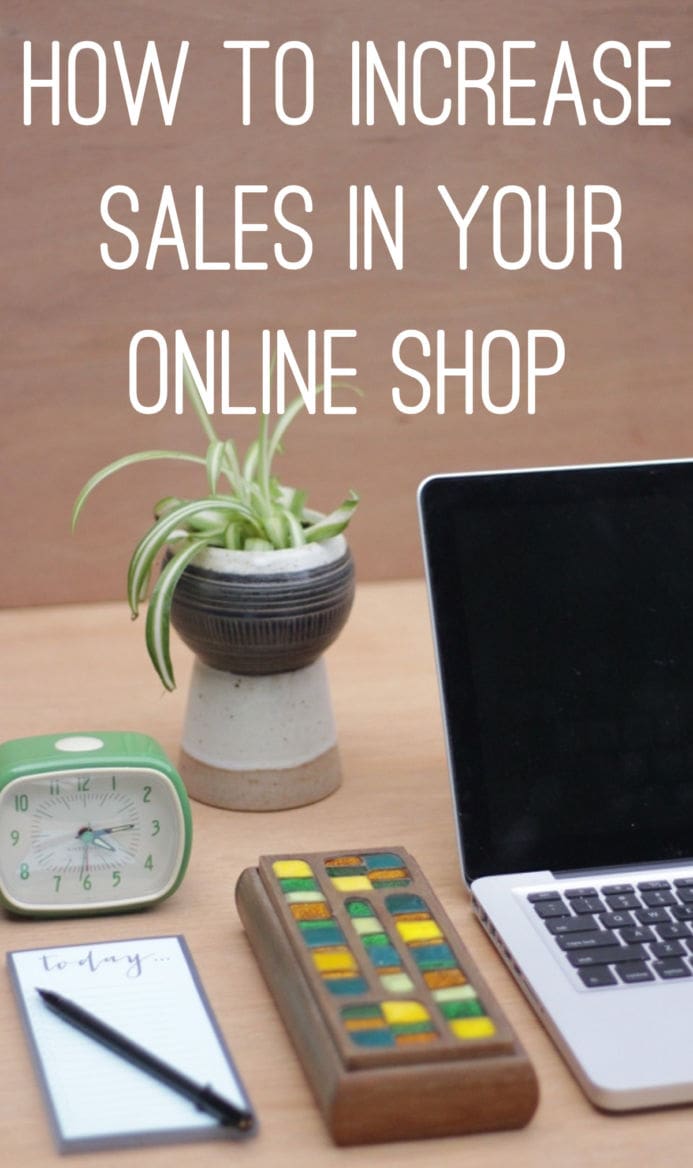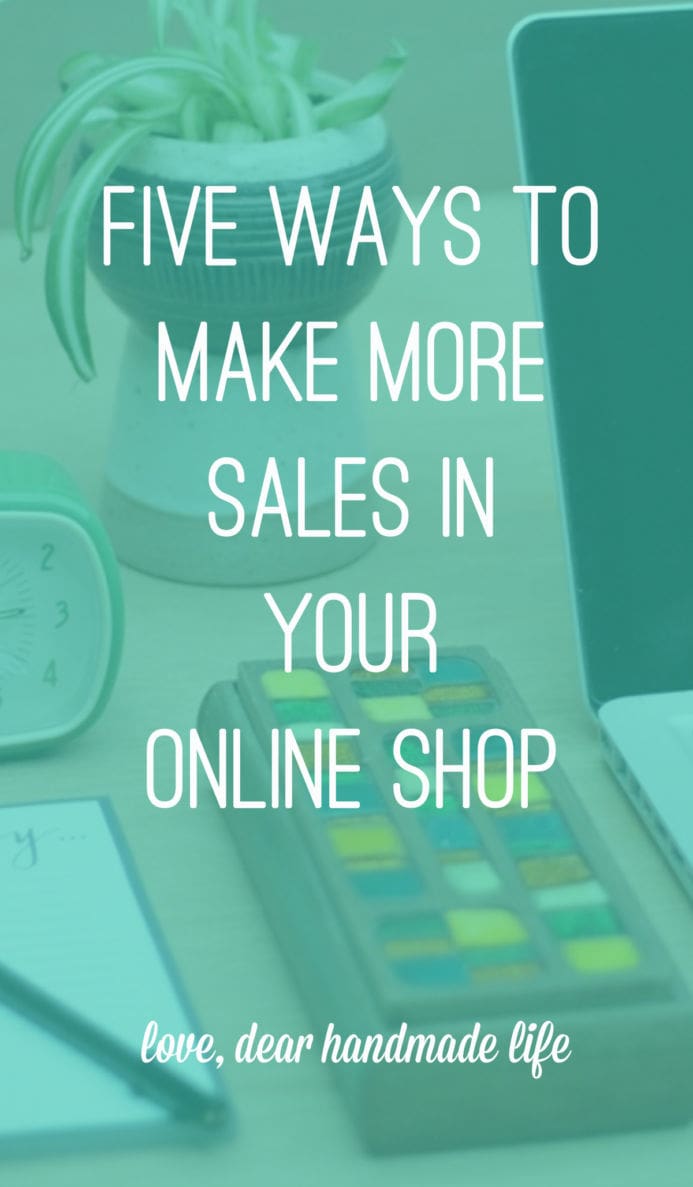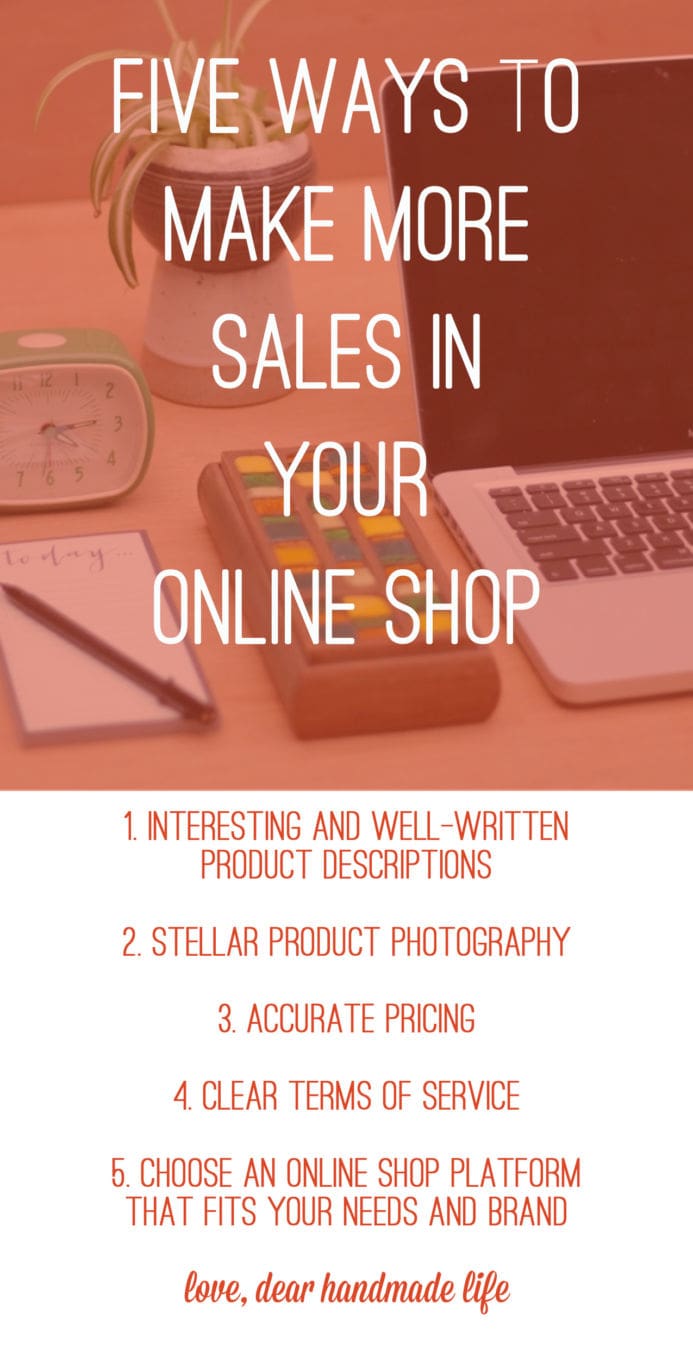How to increase sales in your online shop
I’ll never forget my first online shop. My barber father introduced me to a guy whose hair he cut who made websites. This was 2004! Back then sites like Squarespace and Shopify didn’t exist. Back then it was basically all HTML code. WordPress has JUST started a few months before and Etsy didn’t exist yet. The blogs and websites we had were functional but certainly not the clean, fine-tuned, visually appealing sites we have now. And… EVERYTHING took soooo long.
I took photos of my products with a point and shoot camera then had to wait to develop the film before I headed over the website guy’s house so he could scan in the photos and add them to my site. Seriously folks, I spent many, many, many hours sitting next to the website guy as he worked on my online shop for several months.
Now, you can create an online shop and stock it with products in a few hours. I love the instant gratification of how efficient technology has made running an independent business. But, since you can do everything so fast I think sometimes makers rush through the details that can make your shop stand out and be more dynamic.
It’s tempting to just take a photo of your product, write a quick description and add it to your shop. But, taking the time to make sure every aspect of your online shop is awesome will help you grow your business, save you time and showcase your professionalism. Here are a few tips to help you increase sales and maximize productivity in your online shop.
1. Interesting and well-written product descriptions
I realize that for some people the idea of writing (even if it’s just a short paragraph about your product) leads to sweaty palms and several hours of staring at a computer screen waiting for inspiration to strike. I get it. If you’re willing to push through the fear, sit down and start writing about your product… then begin to tell the story of it, describe what kind of situation or person would use it… get creative! Then you can start adding the facts: be sure to include any pertinent information about size, color, weight, materials etc. This will help you alleviate extra emailing back and forth with potential customers who need to know more before they finalize their purchase. I like to have a few friends check out my listing before it goes live and then I ask them what questions they have about my product. It’s hard to think of everything a potential buyer would ask since you’re so familiar with your product. You know your scarf is made of 40% wool and 60% cotton but a customer won’t, unless you tell them.
A few more tips:
-Be sure your final product description is clear, concise, has all the facts and is interesting.
– Try not to use big words or pretentious language or make obscure references that the general public doesn’t recognize. You don’t want people to have to head to a dictionary to decipher what you’re trying to say.
– Being OVERLY descriptive is never a good choice. Don’t use two adjectives to describe something if one would suffice.
– Have a friend proofread your writing for grammar and spelling errors.
– If writing is not your forte then enlist the help of a friend or consider hiring a writer or doing a trade for product.
2. Stellar product photography
This is one of the biggest mistakes I see beginning creatives make. Just because you can take a photo with your iPhone and upload it to your shop doesn’t mean you should. Product photos should be well-lit, in focus, on-brand and well-composed. I can’t stress this enough! Having less than perfect product photos is like walking into a job interview without showering and while wearing sweatpants. Your photos are the most important part of your online shop. Photos not only give a clear representation of what your product is but also help your potential customer imagine how your product fits in with his/her life. Here are a few posts we wrote that go into deeper detail on how to take stellar product photos:
3 photo styling tips to instantly improve your photography
Three must-have photos to increase sales in your online shop
Four tips for taking awesome online shop and blog photos
How to make DIY photo backdrops
For further study check out our online workshop Photo Styling 101 with Rachel Smith of The Crafted Life.
3. Accurate pricing
This is a BIG one! Creatives tend to underprice and I’ve been know to fall into this trap. We tell ourselves that what we make isn’t worth it. That our customers can find something else from someone else for cheaper. Sadly, this underpricing trend affects not just you but every maker. Underpricing devalues your product as well as other handmade or independently made products.
Pricing your products is NOT a guessing game. You don’t price your products based on what you (or your peers) could afford to pay for them or what you think they’re worth. You price your products based on the cost, time and resources that go into making them. I dedicated an entire chapter (where I go into how to reduce your material and labor costs, how to account for general expenses, share spreadsheets that help you keep track of your finances and more) of my online workshop Craft Show Success to pricing. That’s how important pricing is! If you’re new to selling what you make or feel like your pricing isn’t accurate, then I urge you to check it out. In the meantime here’s a simple pricing formula you can use to get started:
PRICING FORMULA:
Labor + Materials x 2 = wholesale price
Wholesale price x 2 (for overhead and surplus) = retail price
This is a basic formula and the multiplications can be adjusted depending on your overhead and other factors. Some people multiply labor and materials or their wholesale price by 2.5 or 3. But this formula is a good place to start.
4. Clear terms of service
If you’ve ever tried to return something and then realized that you were past the acceptable return date then you know the perils of terms of service that are unclear. Laying all of your terms out clearly and making sure that you have all your bases covered is key to not only saving time of emailing back and forth with customers but also protecting yourself. Craftcation 2016 presenter Kiffanie Stahle (who also happens to be a lawyer) goes into detail on this in this post. You want to be sure that your payment and shipping terms are explained, when your product will ship, what happens if your product doesn’t arrive or arrives damaged and how you deal with refunds and returns. All of this not only helps you legally cover yourself and your business but also cuts down on email questions.
5. Choose an online shop platform that fits your needs and brand
Last week a friend of mine called me in a frenzy. She had been agonizing over weeks about which online shop platform to use. Should she create a WordPress site and add a shopping cart plug-in? And if so which should she use? Marketpress? Woocommerce? Or should she go with Shopify or Squarespace? Or stick with a site that already has an audience like Etsy, Amazon Handmade or aftcra? I told her about my experiences with each one (since at some point in my business I had used them all). But ultimately the decision was hers and she needed to base it on what she needed vs. what the platform was offering. Each one of these has great benefits but also depending on your individual needs may have some drawbacks as well. Sites like Etsy, Amazon Handmade and aftcra all offer you a platform that’s already ready to go and they have built in audiences. However you’re also dealing with being in a sea of other makers. So, though there are tons of people visiting those sites BUT you’re not guaranteed that those visitors will find your products or shop and you’re also at the mercy of their policies that can change at any time. I’m a BIG fan of aftcra because it narrows down the types of sellers that it allows. aftcra sellers must handmake their products and must be living in America. It reminds me of how Etsy was way back in the day. Another great thing is that they have NO listing fees. aftcra was one of our Craftcation 2016 sponsors (we’re pretty picky about who we share with our audience) and I loved that just a few minutes into our first call with aftcra founder Erica I knew she was one of us; a fellow passionate entrepreneur whose belief in the power of community and handmade was the driving force behind everything she does.
Having your own online shop on WordPress, Squarespace, Shopify or a custom built website is great because you can really make it look like your brand but it involves a lot more work.
Whether you choose a platform that already has an audience (like Etsy, Amazon Handmade or aftcra) or an independent one (like WordPress, Squarespace or Shopify) it’s essential that you are driving traffic to your online shop through your social media, newsletter and other marketing avenues. Check out our other business posts for tons of tips on creating an effective social media strategy as well as a newsletter. Craftcation 2016 presenter Meighan O’Toole also has awesome social media strategy and newsletter courses coming up as well as some insightful blog posts.
When you’re creating an online shop it’s essential to take the time to research the best platform for you as well as make everything about your shop professional, a reflection of your brand and efficient.




